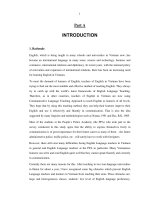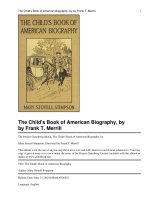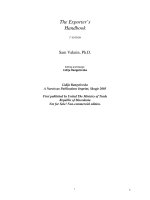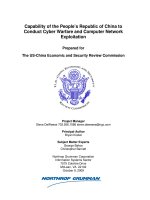The Dressmaker''s Handbook of Couture Sewing Techniques- Essential Step-by-Step Techniques for Professional Results - by Lynda Maynard
Bạn đang xem bản rút gọn của tài liệu. Xem và tải ngay bản đầy đủ của tài liệu tại đây (26.94 MB, 161 trang )
COU 001-007_.indd 1 9/3/10 12:26:27 PM
COUTURE
THE DRESSMAKER’S HANDBOOK
SEWING TECHNIQUES
of
COU 001-007UkA&C_.indd 1 9/3/10 1:20:15 PM
COU 001-007_.indd 2 8/6/10 5:02:29 PMCOU 001-007UkA&C_.indd 2 9/3/10 1:20:15 PM
COU 001-007_.indd 3 8/25/10 10:37:49 AM
LYNDA MAYNARD
COUTURE
THE DRESSMAKER’S HANDBOOK
SEWING TECHNIQUES
of
essential step-by-step techniques for professional results
COU 001-007UkA&C_.indd 3 9/3/10 1:20:15 PM
COU 001-007_.indd 4 8/25/10 10:38:41 AM
A QUARTO BOOK
Published in 2010 by
A&C Black Publishers
36 Soho Square
London W1D 3QY
www.acblack.com
ISBN 978-1-408-12759-9
Copyright © 2010 Quarto plc
All rights reserved. No part of this publication
may be reproduced in any form or by any
means – graphic, electronic or mechanical,
including photocopying, recording, taping,
information storage and retrieval systems –
without the prior permission in writing of
the publisher.
A CIP record for this book is available from
the British Library.
Conceived, designed and produced by
Quarto Publishing plc
The Old Brewery
6 Blundell Street
London N7 9BH
QUAR.COU
Senior Editor: Lindsay Kaubi
Art Editor and Designer: Elizabeth Healey
Art Director: Caroline Guest
Copy Editors: Carol Spier and Liz Dalby
Photographers: Simon Pask and
Martin Norris
Picture Researcher: Sarah Bell
Creative Director: Moira Clinch
Publisher: Paul Carslake
Colour separation by PICA digital Pte Ltd
in Singapore
Printed in China by Toppan Leefung
Printing Ltd
10 9 8 7 6 5 4 3 2 1
COU 001-007UkA&C_.indd 4 9/3/10 1:20:15 PM
COU 001-007_.indd 5 8/24/10 10:12:45 PM
Contents
Introduction 6
Couture technique selector 8
Browse this illustrated guide and go straight to the
couture technique you’re looking for.
The couturier’s kit 12
A guide to all the essential equipment for the couture sewer.
Bindings and finishes 16
Clean, easy and visually appealing binding techniques
for a professional finish.
Design details: on show 50
The visual details and designer flourishes that help
mark out a piece of clothing as ‘couture’.
Design details: concealed 82
The ‘unsung heroes’ of couture sewing: The hidden
details that add real luxury to the ‘feel’ and fit of a garment.
Designer underpinnings 108
Fabrics can be enhanced or inhibited by backing or interlining
with various companion fabrics. This chapter shows you how to
use different fabrics with one another for the best results.
Directory of luxury fabrics 116
A guide to selecting and using linings, interlinings, luxury
fabrics and trims in your sewing projects.
Essential couture techniques 140
A wealth of essential couture sewing know-how.
Glossary 156
Resources 157
Index 158
Credits 160
COU 001-007UkA&C_.indd 5 9/3/10 1:20:15 PM
COU 001-007_.indd 6 8/24/10 10:12:36 PM
6
M
y interest in sewing began in early
childhood at the age of seven. I was inspired
by my mother’s pastel-coloured pillow slips. One day
while she was away at work, I took one and created
my first dress by simply cutting a circular opening for
my head and one for each arm. I proudly wore my
first ‘shift’ around the neighbourhood and the
excitement grew. I next helped myself to two more
pillow slips and engineered a tiered concoction. The
next venture was a real dress made with purchased
yardage. I had the good sense to fold the yardage so as
to have two layers. I positioned myself on the fabric
and directed my best friend to draw around my body
with a crayon. Wherever she encountered an obstacle
(arms and head) the indication was to create an
opening. My brilliance ended there, however. Fabric is
two-dimensional, while the human body has a third
dimension. I was a skinny child, which is the only
way this dress had a chance. I also lacked the good
sense to add seam allowances. Because there was no
machine available, I stitched the dress together by
hand. I proudly put the dress on. It was impossible
to walk, but that didn’t matter, I could hop. Upon
discovering her missing pillow slips and my sad
attempt at dressmaking, my wise mother sought out
private sewing lessons for me and the rest is history.
My particular focus when sewing a garment has
always been technique and detail. This is what
elevates a garment to the status of couture. One must
begin with good quality fabric, and then come the
details. The extra painstaking steps are cumulative
Introduction
and serve to produce a superior product. One can
compare a ready-to-wear garment with a couture
version of the same garment and you will know that
the couture creation is better. It’s in the hang, the fit,
the feel and the details.
Among the details I’ve included in this book are
the satin pocket bag, which feels soft and luxurious,
the organza bubble at the hem, which prevents a
dress or skirt from collecting about the knees; the
couture waistband is clean and crisp, yet ultimately
comfortable, and the high waist facing features
boning as a hidden ally. Some of the decorative details
included in the book are the twin-needle hem, a
professional yet decorative finish, the ribbon-trimmed
collar band, which adds allure to a simple shirt, the
silk charmeuse flange with its picot stitch, adding
dimension and flutter to a lightweight blouse. You will
also find a thorough exploration of couture bindings,
a look at designer underpinnings and a directory of
luxury fabrics used in couture sewing.
My particular passion for technique has inspired
me to study designer and vintage clothing for the
secrets they may contain. Also, I enjoy experimenting
with various methods of handling a specific
construction challenge. This collecting of techniques
and designer details led to this book; I hope you enjoy
them as much as I do, and possibly you will be
inspired to develop new ones of your own.
Lynda Maynard
COU 001-007UkA&C_.indd 6 9/3/10 1:20:15 PM
COU 001-007_.indd 7 8/7/10 10:12:30 AMCOU 001-007UkA&C_.indd 7 9/3/10 1:20:15 PM
COU 008-15-1_.indd 8 8/25/10 1:50:47 PM
8
BANDED V-NECK ON KNIT FABRIC 18
The V-neckline is a focal point of a garment
and should be done well because
inaccuracy is glaring. This band overlaps at
the point, a feature that gracefully enhances
the neckline.
BANDED V-NECK ON
WOVEN FABRIC 22
This method of finishing a V-neck can be
employed by beginning as well as
experienced sewers. It adds no additional
bulk, yet provides maximum stability.
RIBBON BANDED V-NECK 24
Ribbon is a nice alternative to self-fabric for
a banded finish on a V neckline. Use this
technique when you want a delicate, clean-
yet-stable finish for a garment made of soft,
thin, firmly woven fabric.
BANDED CURVED NECKLINE 26
If you’re finishing a curved neckline, this
bias-band edge eliminates the need for a
facing and adds definition. This finishing
technique is appropriate for linens and light-
to medium-weight cottons and silks and
works for armholes as well as at the neck.
Couture Technique Selector
Bindings and Finishes
DOUBLE-FOLD SILK
CHARMEUSE BINDING 30
This technique may be used successfully on
most woven fabrics with a flat surface. For
the samples, both the binding and garment
fabric are silk charmeuse – however, the
charmeuse binding works just as well on
cottons, linens, rayons and other silks.
DOUBLE-FOLD BINDING ON CHIFFON 34
Here is a way to add a charmeuse binding to
chiffon. Finishing the edges of anything made
from chiffon can be a daunting task. But silk
organza comes to the rescue.
FREE-FLOW CHARMEUSE BINDING
ON CHIFFON 36
This is an innovative method for hemming
chiffon. Double-fold silk charmeuse binding
is employed to provide an artfully clean finish
to the hem while adding a subtle shimmer of
light and movement.
PIPED DOUBLE-FOLD BINDING ON
WOVEN FABRIC 37
This is the twin-sister technique to Double-
Fold Silk Charmeuse Binding on page 34.
Charmeuse is so fluid, it’s tricky to handle,
but when your fabric is more stable, this
technique will produce a similar effect with a
lot less effort. This version is sewn first to the
wrong side of the garment, and then
wrapped to the front, with piping tucked
under the edge on the right side.
COU 008-15-UK_.indd 8 9/3/10 2:18:14 PM
9COUTURE TECHNIQUE SELECTOR
CHANNEL-STITCHED ACCENTS 52
When backed with cotton flannel, silk
charmeuse becomes more stable, easier to
handle and heavier. Securing the charmeuse
to the flannel with rows of parallel stitches
(known as channel stitching) ensures the
layers handle as one and adds a decorative
detail to cuffs, collars, bodices or hemlines.
CORDED ACCENTS 54
When cording is placed beneath the face
fabric, subtle textural changes take place,
adding depth and surface design to the
garment. This interesting designer touch can
be applied to collars, cuffs or hembands.
PETERSHAM ‘PEEK’ SEAM 56
If you construct a pencil skirt with flat-felled
seams it’s easy to slip a length of Petersham
ribbon into each side front seam. The result
is an updated wardrobe staple, with new
vitality coming from the contrasting colour or
texture of the trim that peeks from the seams.
PETERSHAM ‘PEEK’ ON A
WRAP SKIRT 57
Embellish the loose edge of a wrap skirt (or
a fake wrap) with Petersham ribbon to look
like the trimmed flat-felled seams on the
pencil skirt.
SINGLE-FOLD BINDING ON
KNIT FABRIC 40
The following technique is a mainstay for
knit edges: necklines, armholes or hemlines.
A tee or tank should be effortless to wear,
comfortable and require minimal care.
This technique emulates the expensive
designer tee or vest top that is made
with specialized equipment.
BABY FRENCH BINDING 44
This simple, clean finish is really a skinny
bias facing that’s secured from the right
side with a twin needle. It’s useful on
lightweight, ethereal tops and for layered
looks. It is ideal for handkerchief linen and
other lightweight woven fabrics such as
voile, batiste, organdy and China silk.
SINGLE-FOLD BINDING ON CHIFFON 46
To give chiffon a polished finish with just a
touch of dimension, make a narrow self-
binding. As with the Double-Fold Charmeuse
Binding on Chiffon, begin by supporting the
edge with silk organza.
BABY FRENCH BINDING
ON CHIFFON 47
If you’d like a clean simple finish that doesn’t
show on the right side, you can finish chiffon
with a Baby French binding
Design Details: On Show
COU 008-15-UK_.indd 9 9/9/10 9:36:15 AM
10 COUTURE TECHNIQUE SELECTOR
HONG KONG FINISH ON
THE OUTSIDE 59
This traditional method of finishing seam
allowances with a binding is known as the
Hong Kong finish. This fresh variation places
the finished seam allowances on the outside
of the garment.
WIDE CHARMEUSE HEM BAND 62
This method of finishing a hem is decorative
as well as functional. The subtle shimmer of
the charmeuse looks a bit like icing on a
cake, and the band lends weight to the
bottom of the garment.
RIBBON-TRIMMED HEM 64
This technique gives a neat, clean finish and
is often used on sheer fabrics. The ribbon
adds stability and definition to the hemline
and nicely finishes the inside, too.
DECORATIVE TRIM HEM 65
This hemming technique applies trim with no
added bulk and finishes the inside of the
garment cleanly as well. Trim provides added
weight to improve the hang of a garment.
FLANGE CLOSURE FOR CHIFFON 66
This front closure evolved as a method for
handling chiffon without adding bulk and
tedious hand finishes. The centre front
flange offers enough stability to house
machine-worked buttonholes.
CHARMEUSE WELT EDGING 68
It is important to maintain the fluid drape
of soft fabrics, but the edges need a
graceful finish. The charmeuse welt does
the job beautifully.
CHARMEUSE WELT EDGING:
ADD A PICOT FINISH 69
The addition of the picot or scallop stitch to a
charmeuse welt lends a touch of delicate
femininity. This finish would work well on
sheer or lightweight fabrics.
RIBBON-TRIMMED COLLAR BAND 70
All you need to do to add an artful detail to a
classic band-collar shirt is sew a piece of
ribbon onto the inside of the band. The ribbon
will be visible when the shirt is worn
unbuttoned, adding a bit of allure.
BONED CUFF 74
This cuff technique is useful when a sharp
point or a bold shape is required. It can also
be applied to collars. The stiff interfacing
used here gives an internal ‘skeleton’ to
support the cuff shape.
SHOULDER PAD 76
A shoulder pad should be a discreet padding
used to improve and support the shoulder
area of a garment. It should provide an
internal structure or ‘skeleton’ to ensure
that the garment holds a perfect shape.
BUTTON-ON GARMENT SECTIONS 78
This designer technique makes a playful
statement, ‘now you see it, now you don’t’.
Separate button-on pieces allow the wearer
to derive different looks from one garment.
COU 008-15-UK_.indd 10 9/9/10 9:36:36 AM
11COUTURE TECHNIQUE SELECTOR
LINING/BINDING SKIRT PANELS 84
This technique works well on seams with
minimal curves. It is suitable for panel skirts,
trousers and unstructured rectangular
jackets. It results in the garment being lined
and seams finished with minimal effort.
COUTURE WAISTBAND 86
The couture method of constructing a
waistband results in a superior product: the
band does not roll, yet it is comfortable, lies
flat and there is no extra bulk.
HIGH-WAIST COUTURE FACING 88
This approach to constructing a waist facing
works well on any waistline where a
waistband is not desired. The channel
stitching and the bones add structure and
support while maintaining a clean line.
EASY TWIN-NEEDLE HEM 90
This hem gives your garment a sporty,
energetic look – with no rippling. It is
especially good for knit or woven fabrics with
Lycra introduced to provide some stretch.
ORGANZA ‘BUBBLE’ HEM FINISH 92
To prevent the lower edge of a sheath dress
or skirt from collapsing close to the legs, slip
a folded bias band of organza between the
hem allowance and garment body to make a
bubble-like spacer inside the hem.
FACED HEM 94
A faced hem is the perfect way to finish a
skirt where a deep hem is required. Facing
pieces from the skirt pattern are sewn to the
lower edge and pressed to the wrong side,
where they fit perfectly.
HORSEHAIR BRAID HEM 96
To support a hem and give it more rigidity,
you can sew horsehair braid (or ‘crin trim’)
to the hem. Horsehair braid supports the
hem without adding bulk and keeps it
from collapsing.
CONCEALING HORSEHAIR BRAID
IN THE HEM 97
Horsehair braid has a rough texture that
could, if not totally concealed, snag tights.
For this reason it is best to ensure that it is
fully concealed.
BALANCED DART 98
By balancing the dart with extra fabric,
a flatter, smoother finish can be achieved,
even though fabric has been added.
COUTURE DART 100
This dart technique works well on all fabrics,
and it is essential when working with sheers.
There are no unsightly thread ends at the tip
of the dart… just a clean, graceful finish.
SATIN POCKET BAGS 102
The satin pocket bag is a luxurious detail,
not meant to be seen by the casual observer
but sure to enhance the mood of the wearer
when the sumptuous feel of satin greets
your fingers when you slip your hand into
your pocket.
WAISTLINE ‘FLIP-OUT’ POUCH 105
A little zipped hanging pocket to add to the
inside of trousers or skirts to provide secure
hidden storage for a credit card, change
or lipstick.
Design Details: Concealed
COU 008-15-UK_.indd 11 9/9/10 9:36:41 AM
COU 008-15-1_.indd 12 8/25/10 1:51:53 PM
The Couturier’s Kit
The wide array of machines, feet and haberdashery available for sewing is an
invitation to expand your horizons. Leaping out of your comfort zone and
experimenting with equipment is imperative to growth and enhancing your
body of sewing knowledge. You will learn the importance of having just the right
needle or foot to complete the job as you gain experience – but on the next few
pages you will find a suggested ‘Couturier’s Kit’ of items that you will find
very useful when working on the techniques in this book.
12
OVERLOCKER
Overlockers have come into general use and many sewers have
one to accompany their basic sewing machine. They perform many
functions and produce a manufactured, ready-to-wear look. As with
any other major purchase, research and experiment to find the one
that suits your needs.
SEWING MACHINE
Sewing machines have evolved into computerized devices that are
capable of highly technical manoeuvres. There are special machines
designed for specific tasks. In fact, there is a machine for almost
each task in the manufacturing process: machines to install sleeves,
buttonhole machines, hemmers, rufflers, binders, etc. The home
sewing enthusiast, however, usually assesses her skill level and
her requirements, and purchases a machine to fulfil her needs.
It is important to read about and try out various makes and models
to find a comfortable ‘fit’.
SEWING MACHINE FEET
It is not required to own all of these sewing
machine feet but each one certainly helps
with specific tasks. Many sewers become
frustrated because they are unaware of the
help available with the use of the proper foot.
COU 008-15-UK_.indd 12 9/3/10 2:18:14 PM
COU 008-15-1_.indd 13 8/25/10 1:51:56 PM
Cording Foot: This foot has a hollow
space that holds the cord securely
in place while attaching it to
the garment.
Top Stitch Foot: This foot has a built-
in guide which assists with more
even stitching.
Zip Foot: When there is more bulk on
one side than the other, this foot
allows stitching directly next to the
bulk, for example, zip teeth or
a cord.
Single-Hole Throat Plate: This throat plate
does not allow sideways needle movement. The
opening is very small, so there is more control
when working with delicate fabrics. The
likelihood of the fabric being drawn into the
mechanism of the machine is greatly reduced.
Walking Foot: For long seams,
hems on stretch fabric, multiple
fabric layers.
Knit Foot: This foot is shorter and the
toes are slightly lifted so it does not
push the fabric.
Roller Foot: This foot grasps the top
layer of fabric so it will feed at the
same rate as the bottom layer,
allowing more control without
added friction.
Straight Stitch Foot: For straight
stitching (especially on fine fabric).
Works in combination with the single-
hole throat plate.
Pintuck Foot: For creating twin-
needle tucks to decorate fabric.
COU 008-15-UK_.indd 13 9/3/10 2:18:14 PM
14
SEWING MACHINE NEEDLES
Needles fall into a similar category as
sewing machine feet. The right needle
ensures success with specific fabrics.
It is recommended, that you purchase the
appropriate needle before beginning a new
project or working with a new fabric. Also,
it is of great importance to change needles
regularly, since they become dull and can
snag or mar your fabric.
Pinking shears
Dressmaker’s shears (right), pelican
scissors (above left), tailor-point shears
(above right).
Dressmaker’s pins
Topstitching thread
Safety pins
Twin Needles
Two or three needles fixed to a single body for
parallel rows of stitching.
Twin Needle For Wovens: This needle stitches two
parallel rows of stitching at the same time, producing
a professional, yet decorative overall stitch.
Twin Needle For Knits: This needle performs the
same function as above, but has a slightly rounder
point to push the knit fibres aside.
Stretch Needle:
This needle is used for fabrics containing Lycra/
Spandex. Due to its long scarf, it helps to prevent
skipped stitches.
SHEARS AND SCISSORS
Shears for cutting fabric are a must, but so are tailor-
point shears for getting into tight corners. Pinking
shears provide a great seam finish and pelican
scissors assist in close trimming of fabric layers.
SHARP PINS
Absolutely indispensable in the whole process of
garment construction. Pins need to be sharp to
avoid snagging or marring the fabric.
Quilting Needle:
This needle has a longer point so it can sew through
multiple layers.
Sharp Universal Needle:
This needle is generally used for sewing most
woven fabrics.
Microtex Needle:
This needle has a very sharp point and is appropriate
for sewing silks and chiffons.
THE COUTURIER’S KIT
COU 008-15-UK_.indd 14 9/9/10 9:36:55 AM
COU 008-15-1_.indd 15 8/25/10 1:52:04 PM
15THE COUTURIER’S KIT
STEAM IRON AND IRONING BOARD
Pressing as you work is almost more important
than the sewing. It is essential to press at each
step of the process for maximum results. Once
the garment is completed, several important
areas are no longer accessible and it is too late
to flatten or steam out puckers and folds. Steam
helps set design and construction details.
PRESSING AIDS
Pressing aids such as a press cloth, seam stick
(seam roll), point presser and point turner are
inexpensive and indispensable. These provide
great assistance during the pressing process
and they help to produce a superior product.
Seam stick
(seam roll)
Point turner
Ruler and
skirt curve
Tissue paper and
pattern weights
Tailor’s chalk
Point presser
RULERS AND CURVES
Well, these are a must! Straight rulers
and skirt curves are all required for pattern
work as well as garment construction. The clear
plastic ones have the added benefit of transparency
to help reduce errors.
HAIRGRIP
This everyday item is supremely helpful in turning fabric
tubes, such as spaghetti straps.
PATTERN WEIGHTS
This is a wonderful method of securing the pattern on the
fabric before cutting. Pins can snag or mar the fabric and
applying weights takes much less time.
TISSUE PAPER
This comes in handy as a temporary stabilizer when
working with sheer, fluid fabrics such as charmeuse
and chiffon. It can be placed under the fabric to
facilitate cutting.
CHALK
We all need a method to mark our fabric for construction.
There are several options on the market, including
pencils, chalk wheels and soapstone. Find one that
suits your purposes.
COU 008-15-UK_.indd 15 9/3/10 2:18:14 PM
COU 016-049_.indd 16 8/25/10 7:30:21 PM
Bindings and
finishes
CHAPTER ONE
The binding techniques in this chapter have been developed to
make them cleaner, easier and timesaving, resulting in
professional, visually appealing garments.
Traditional facings have always been the dressmaker’s
nemesis. They are the pesky pattern pieces that seem to fly off
the workspace never to be seen again. Also, they tend to be
bulky and not lie flat against the body – facings seem to make
an appearance without an invitation. They roll out of the
garment and advertise brand and size to casual observers.
These techniques display ways of finishing outer edges and
curves of garments that are facing-free. They are versatile and
have a broad application across a number of different types
and styles of garments.
COU 016-049UK_.indd 16 9/3/10 2:39:47 PM
COU 016-049_.indd 17 8/25/10 6:41:24 PM
Precise finish
Precision in executing edge finishes
will create clean, graceful, figure-
enhancing lines.
Giorgio Armani, Spring/Summer 2010,
Paris Fashion Week
COU 016-049UK_.indd 17 9/3/10 2:39:47 PM
COU 016-049_.indd 18 8/25/10 6:41:27 PM
18 BINDINGS AND FINISHES
Banded V-Neck on
Knit Fabric
The V-neckline is a focal point of a garment and should be done well because
inaccuracy is glaring. This band overlaps at the point, a feature that gracefully
enhances the neckline and can be successfully accomplished on various angles
with equal ease. Use this technique when you want a clean, simple method to
finish and highlight a V-neckline and don’t want to get involved with the more
complicated and tedious process of making a band that mitres at the point of the
V. The fabric for the band may be the same colour as the garment or a contrast.
Fusible interfacing for knits: this allows •
the knit to retain some stretch for comfort.
Twin needle for topstitching, optional•
Foot designed to sew knits, recommended •
Stabilize the neckline
1. Interface the neckline
Cut a piece of fusible interfacing the shape of the neckline for
each garment piece, making it the width of the seam allowance
plus 1cm (
3
⁄8"). Fuse each strip to the wrong side of its piece,
positioning it so it covers the seam allowance. This will stabilize
the area and facilitate smoother topstitching.
2. Stitch along the seamline
Staystitch the entire neckline directly
on the seamline using a stitch length of
2.5mm (10 stitches per inch). Near the
point of the V, shorten the stitch length
to 1 or .75mm (24 stitches per inch).
This tiny stitch eliminates the need
for backstitching and further
reinforces the point.
Note
• It is of the utmost importance to have the point of the V perfectly situated and
not offset to the left or right. For this reason, it is helpful to mark the V area
with a ruler and a fine chalk line before staystitching.
Front Back
S
E
W
I
N
G
T
O
O
L
S
A
N
D
M
A
T
E
R
I
A
L
S
•
COU 016-049UK_.indd 18 9/3/10 2:39:47 PM
COU 016-049_.indd 19 8/25/10 6:41:39 PM
19BANDED V-NECK ON KNIT FABRIC
Prepare the band
3. Cut the neckband strip
Sew and press the shoulder seams.
Measure the length of the entire neckline
and add 10cm (4"); this is the length to
cut the band. Decide how wide you want
the band to be and add the width of your
seam allowance; double this dimension
to find the width to cut the band. Cut the
band in your determined dimensions on
the crossways grain of the knit fabric – so
that the stretch runs the length of the
band. This makes it easier to apply the
band to the back neckline curve.
4. Fold and press the strip
Fold the neckband strip in half lengthways,
right side out, and press. You may overlock
the long cut edge for a professional look.
Attach the band
5. Position and stitch in place
Place the garment right side up. Align the cut edges of the
band with those of the garment, leaving a tail about 5cm
(2") long extending past the point of the V as shown; pin
at the V and a short way up the neckline but not around
the back of the neck. Once the band has been correctly
positioned, it is easier to stitch from the wrong side, where
the staystitching is visible. Starting exactly at the point,
stitch directly on top of the staystitching. Use a tiny stitch
setting, .75 to 1mm (24 stitches per inch), near the point
and don’t backstitch; backstitching will cause unnecessary
thread build-up and adds bulk.
A tiny stitch setting is used
near the point of the V.
COU 016-049UK_.indd 19 9/3/10 2:39:47 PM
COU 016-049_.indd 20 8/25/10 7:30:55 PM
20 BINDINGS AND FINISHES
Note
• For those of you who are wondering which
way the overlap will form, the side of the
band stitched first will be on top.
7. Press and trim the neckline
Press the work as sewn to embed the stitches, then
very carefully (using sharp scissors) clip only the
garment fabric to-but-not-through the staystitching at
the V. Grade the seam allowances (the allowance
closest to the body should be the narrowest) and press
them all towards the garment. The band will now fill
in the V-neckline and the allowances will support it.
Note
• Now is the time to check
and make sure your band is an
even width all the way around
the neckline.
8. Finish attaching the band
With the garment wrong side
up, slide the unattached end of
the band over the secure end
and pin it in place.
6. Continue stitching
Continue around the neck, gently
coaxing the band to lie flat around the
back neckline curve. Stop stitching
about 2.5cm (1") before you reach the
V point (or at least as far as the band
width); this creates a space for the
band end to overlap.
COU 016-049UK_.indd 20 9/3/10 2:39:47 PM
COU 016-049_.indd 21 8/25/10 6:41:49 PM
21BANDED V-NECK ON KNIT FABRIC
9. Trim the band tails
Check from the right side to see that
the overlap is flat and neat. Continue
stitching the band to the remainder of the
neckline; stop exactly at the point. Pivot
your work and stitch the end of the
underlap to the overlap at the V and trim
away the excess band tails.
Style suggestion
• The band finish is a great way to
showcase the V-neckline on this T-shirt.
10. Topstitch the neckline
Topstitch from the right side
through all thicknesses. You may
use a twin needle or contrasting
thread for added panache.
The band tails
from the wrong
side.
COU 016-049UK_.indd 21 9/3/10 2:39:47 PM
22 BINDINGS AND FINISHINGS
Banded V-Neck on
Woven Fabr ic
This method of finishing a V-neck can be employed by beginning as well as experienced
sewers. This is a companion technique to Banded V-Neck on Knit Fabrics, page 18, with
a couple of adjustments. There is no need to interface the entire neckline because you are
working with woven, non-stretch fabrics. However, it is imperative to stabilize the point
of the V for successful implementation of the technique. Silk organza is a good choice
for this because it is lightweight and strong. It adds no bulk,
yet provides maximum stability.
Stabilize the neckline
1. Interface the point of the V
Hand-tack the square of silk organza to
the wrong side of the garment just below
the cut edge of the V. Although it’s
tempting to use a bit of fusible interfacing
instead, a fusible is sometimes visible on
the finished garment and therefore not
optimal. The edges of the organza are
pinked and loose and so will not imprint
onto the face of the garment.
2. Stitch along the seamline
Staystitch the entire neckline directly on
the seamline using a stitch length of
2.5mm (10 stitches per inch). Near the
point of the V, shorten the stitch length
to 1 or .75mm (24 stitches per inch).
This tiny stitch eliminates the need for
backstitching and further reinforces the
point. Backstitching in this area can pull
the garment into the netherworld beneath
the throat plate and cause a mini crisis.
Make the band
3. Cut the neckband strip
Sew the shoulder seams and press the
allowances open. Because you’re working
with woven fabric, you’ll need a bias strip
of fabric for the band – this will enable it
to follow the back neckline curve. Measure
the length of the entire neckline and add
10cm (4"); this is the length to cut the
band. To find the width, first decide how
wide you want the band to be and add the
width of your seam allowance; double this
dimension and add a bit more to account
for shrinkage when you stretch-press the
band (see opposite). The amount to add
varies from 3mm to 1cm (
1
⁄8" to
3
⁄8")
depending on the fabric. Cut a bias strip
of the required size.
S
E
W
I
N
G
T
O
O
L
S
A
N
D
M
A
T
E
R
I
A
L
S
•
A scrap of silk organza 3.75cm •
(1
1
⁄2") square
Twin needle for topstitching, •
optional
COU 016-049UK_.indd 22 9/9/10 9:47:28 AM
COU 016-049_.indd 23 8/25/10 6:42:04 PM
23
Couture Secret
One of the advantages
of this method of
handling a V-neck on a
garment made of woven
fabric is that the band
provides support at the
point of the V. When a
traditional facing is used
instead of a band, the
seam allowance is
clipped at the V, folded
down onto the body, and
pressed flat on either
side of the point, leaving
a bit of a crater below
the point that is not
attractive.
BANDED V-NECK ON WOVEN FABRIC
Couture Secret
Silk organza is an indispensable item in the couturier’s
supply arsenal. Use it to interline and interface
garment sections, stabilize curves and angles,
tape straight edges and steady wiggly
fabrics for specific procedures.
4. Press, fold and press the strip
Stretch press the bias strip (see right). Then fold the
strip in half lengthways, right side out, and press
again. You may overlock the long cut edge for a
more professional look.
5. Attach the band
To attach the band, follow steps 5
through 8 of Banded V-Neck on
Knit Fabric, pages 18–21.
Stretch-pressing
Once a bias strip has been cut out, be sure to ‘stretch-
press’ it before sewing it to your garment. This
important step prevents the strip from rippling and
pulling later. Pin one end of the strip to your pressing
surface and slightly pull the strip as you steam with the
iron. The bias will shrink and become narrower. This is
why you start with a wide strip.
Cut a bias strip for
the banding.
Style suggestion
• This technique works well on bateau necklines also,
since each shoulder seam join functions as a V. Try
using a contrasting fabric or colour, or experiment with
bias stripes for added dash.
COU 016-049UK_.indd 23 9/3/10 2:39:47 PM
COU 016-049_.indd 24 8/25/10 6:42:19 PM
24 BINDINGS AND FINISHES
Ribbon-Banded V-Neck
Ribbon is a nice alternative to self-fabric for a banded finish on a V-neckline.
Use this technique when you want a delicate, clean-yet-stable finish for a
garment made of soft, thin, firmly woven fabric such as the cotton batiste shown
here. If you like, you can add a zigzag stitch embellishment to the applied ribbon
to create a picot edge – this variation is charming and has a refined sensibility.
This is a great neckline and armhole finish, but it may be used elsewhere as well.
Soft ribbon (rayon works well), 1.25cm •
(1½")
wide and a bit longer than the
neckline circumference
Small, sharp scissors for close trimming; •
stork scissors are ideal
Attach The Ribbon
2. Position and stitch in place
Place the garment right side up. Beginning
at the V, position the ribbon along the
neckline so that about 3mm (
1
⁄8") extends
into the seam allowance as shown. Follow
steps 5 and 6 of Banded V-Neck on Knit
Fabrics, pages 19–20, to sew on the ribbon
and press it towards the neck opening.
Stabilize the neckline
1. Stitch along the seamline
Sew the garment shoulder seams and
press. Staystitch the neckline directly on
the seamline using a stitch length of
Staystitch the neckline using
a stitch length of 2.5mm
(10 stitches per inch).
Near the point of the
V shorten the stitch
length to 1 or .75mm
(24 stitches per inch).
S
E
W
I
N
G
T
O
O
L
S
A
N
D
M
A
T
E
R
I
A
L
S
•
Note
• Here, interfacing is not used at the neckline because there would be show-through; however, if you feel the
need for more control, use a single-hole throat plate and a straight-stitch foot when staystitching. A single
layer of tissue paper placed between the fabric and the feed dogs works as a temporary stabilizer.
2.5mm (10 stitches per inch). Near the
point of the V, shorten the stitch length
to 1 or .75mm (24 stitches per inch).
This tiny stitch eliminates the need for
backstitching and further reinforces
the point.
COU 016-049UK_.indd 24 9/3/10 2:39:47 PM









